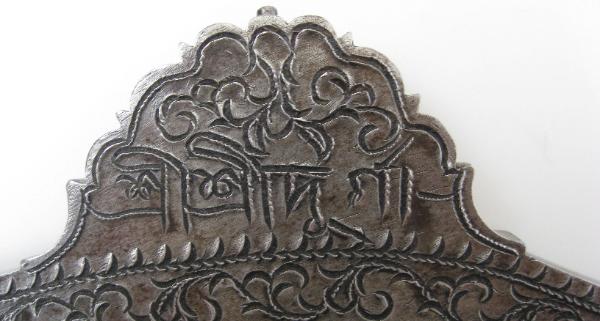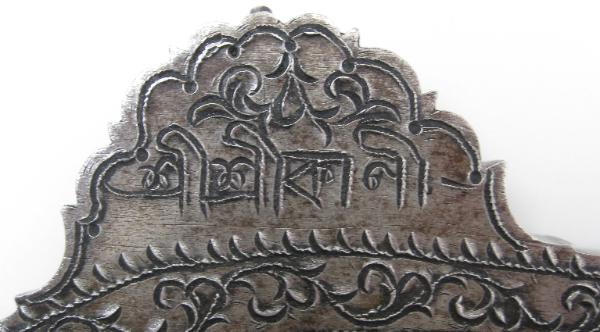
733. Ram Dao, Nepal




Detail – the script on either side of the blade.
Excerpt from:
Inside Knowledge: Streetwise in Asia
by Michael Backman (Palgrave-Macmillan, 2005), p. 98:
“
H
indu cosmology has four ages. In which do we live? We live in the worst. The gods Vishnu and Shiva are asleep and do not hear the prayers of their devotees. It is an age when the natural order of things breaks down, an age of corruption and violence. Two world wars, nuclear weapons, international terrorism, even global warming are all products of this age. It is the Age of Kali, the consort of Shiva. And so I visit the temple of Dakshinkali, 20 kilometres outside Kathmandu. It is the most important temple in this overwhelmingly Hindu country. It is devoted to Kali. The temple stands at the edge of a still, dark valley, surrounded by forested hills and at the confluence of two rivers.
I stand in the temple’s forecourt, my bare feet mired in mud and blood, for Kali requires sacrifices, and specifically, the blood of uncastrated male animals. For more than an hour I watch various animals – three goats, chickens and ducks – have their throats cut open. The butchers hold each terrified, dying animal aloft, and sway it to and fro, with one hand on the body of the animal and the other beneath its chin so that the neck wound gapes open. Sliced jugular veins spray steaming blood onto a row of stone statues of Kali and other gods. Some release their contents with a whimper. Others do so geyser-like, the dark red ejaculate splashing out in a series of angry gushes, draining the kicking animal of life and spirit.
A sacrifice to Kali is designed to lessen whatever ills one might be suffering and so businessmen, politicians and even students hoping to avoid bad exam results make the trek to the temple to pay for animals and then pay again to have them killed. Want to have a safe plane journey abroad? Then sacrifice a goat. Want to stave off the collapse of your bank? Then better sacrifice several buffaloes. The car park higher up the ravine fills with buses of pilgrims from India and the Mercedes of Kathmandu businessmen. I turn to leave, my feet freezing and bloodied. A mad woman shrieks as she smashes a coconut over a stone lingam. That’s one thing that seems to cross cultures: the hard end of religion attracts the mentally ill.”
Exceptional Ram Dao Sacrifice Sword
Kathmandu Valley, Nepal
19th century
length: 62.0cm, height at widest point:18.5cm
This large, elaborate sword – a ram dao – is for sacrificing animals, particularly larger animals such as buffaloes. It is designed to sever their necks or to entirely decapitate their heads as part of ceremonies designed to appease the Hindu goddess Kali. (Human sacrifices to Kali were abandoned in Nepal in the 18th century.)
It is one of the finest
ram dao sword we have encountered. The blade, in steel, has a dramatic, undulating shape. A chased band of foliage decorates the upper edge, which is surmounted by an architectural-type crest etched on both sides with two short inscriptions in Ranjana script, the script that is used by the Newar people up until the mid-20th century. Like Devanagari script, Ranjana script evolved from the now extinct Brahmi script and was in use from the eleventh century.
The blade terminates with a round finial. The handle is of wood that has been carved with a lattice-work grip. It terminates with a brass end, and is attached to the blade by means of a heavy, solid brass mount that is cast with a single lotus-bud rising from between a pair of leaves, a motif that symbolises Kali in Nepal and in Bengal.
The Newar people are indigenous to the Kathmandu Valley although today, they account for less than 6% of Nepal’s population. Around 80% are Hindu and most of the remainder are Buddhists.
Overall, this is a rare, splendid piece. It has enormous presence and is highly decorative.
Provenance
from a private UK collection.
References
Elgood, R., Hindu Arms and Ritual: Arms and Armour from India 1400-1865, Eburon, 2004.
Inventory no.: 733
SOLD

